
1. Piaget’s Cognitive Development Theory.
1.1. Stages of Cognitive Development
1.1.1. Sensorimotor: Birth to 2 years old
1.1.2. Preoperational: 2 to 7 years old
1.1.3. Concrete operational: 7 to 11 years old
1.1.4. Formal operational: 12 years and older
1.2. Key Concepts
1.2.1. Stages of Cognitive Development: Sensorimotor, Preoperational, Concrete Operational, Formal Operational
1.2.2. Schemas: Mental structures that help organize knowledge
1.2.3. Assimilation & Accommodation: Processes of adapting to new information.
1.3. Learning Processes
1.3.1. Constructivism: Children build knowledge through active exploration.
1.3.2. Problem-solving: Adapting thinking to understand the world.
1.3.3. Adaptation: Adjusting schemas when encountering new experiences.
2. Vygotsky’s Sociocultural Theory
2.1. Key Concepts
2.1.1. Zone of Proximal Development (ZPD)
2.1.1.1. The gap between what learners can do independently and what they can do with guidance
2.1.2. Scaffolding
2.1.2.1. Support given to learners to help them accomplish tasks within the ZPD
2.1.3. Cultural Tools & Social Interaction
2.1.3.1. Language and social context are vital for cognitive development.
2.2. Learning Processes
2.2.1. Collaborative Learning
2.2.1.1. Learning through social interaction with peers and adults
2.2.2. Internalization
2.2.2.1. Transition from social speech to private speech to internal thinking
2.2.3. Language Development
2.2.3.1. Language as a tool for thinking and problem-solving
3. Bandura’s Social Learning Theory
3.1. Key Concepts
3.1.1. Observational Learning
3.1.1.1. Learning by watching others and imitating their behaviors
3.1.2. Modeling
3.1.2.1. Demonstrating behaviors that others can observe and replicate
3.1.3. Self-Efficacy
3.1.3.1. Belief in one’s ability to succeed in specific situations
3.2. Learning Processes
3.2.1. Imitation
3.2.1.1. Reproducing observed behaviors
3.2.2. Motivation
3.2.2.1. Reinforcements and punishments that influence the likelihood of behavior being repeated
3.2.3. Self-regulation
3.2.3.1. Controlling one's behavior through internal cues and external feedback
